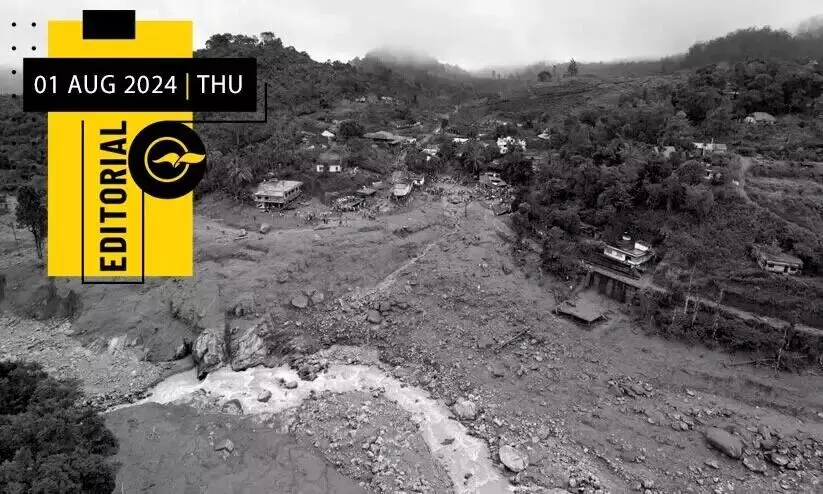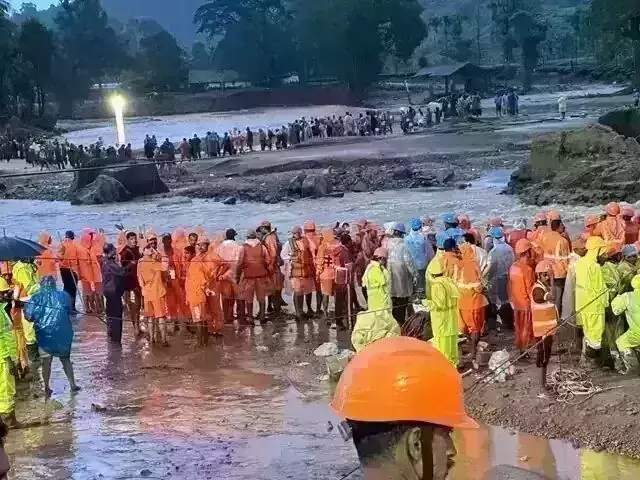
Lend ears to new slogans of green politics
text_fieldsTwo villages had disappeared from the map of Kerala by the time dawn broke. Mundakkai and Chooralmala near Meppadi in Wayanad district of Kerala will now be known for the disaster that tore the land apart. Those villages and the lives lost in Chaliyar by explosively raging water flow are not the first experience of Kerala. In the last seven years, the small state has witnessed seven major natural calamities. They include the great deluge that resulted in the death of more than 480 people in 2018, in 2019 landslides in Kavalappara in Malappuram district and Puthumala in Wayanad, in 2020 landslide in Pettimudi in Idukki, and the following year Koottickal in Kottayam district and Kokkayar in Idukki. When will we understand the sign and warning that the land of Kerala is disappearing from the map through this endless flood of natural calamities? The question is raised from different quarters of society whether such series of disasters can still be called 'unexpected' and can be solved only through voluntary services and rehabilitation. These questions are based on the realization that the regular rescue operations and rehabilitation of victims led by various agencies and voluntary organizations of the central and state governments will not be sufficient for the foreseeable future.
Comprehensive and systematic approaches are needed to deal with disasters caused by climate change and human intervention in the environment. During the last 20 years, Kerala's climate itself has undergone major changes. Earlier, the Edavapathi rain from June to September and the later the rains of the month of Thula were balanced so that they could be predicted more or less accurately. If we look at the last 200 years, there are no significant fluctuations. We have followed 'calendars' in accordance with this climate in all fields of agriculture, education and work. However, things have changed since 2001. Now June and mid-July give clear sky even without clouds. August and September are the months of the year when rainfall should be less. This often leads to floods. Although there is no significant difference in the total rainfall, the distribution level has changed almost completely. Floods and landslides are the continuation of this change happening. This difference in rainfall distribution also causes drought on the other hand. This is not just about Kerala; this is evident globally. In 2018 when the great flood occurred, no one has forgotten how many similar or even more terrible natural phenomena occurred in 18 other states of India. There were other natural disasters, including blizzards and heat waves. Kerala has still not prepared 'calendars' according to these changes. This is the biggest proof that the state is lagging far behind in environmental literacy even as it boasts of being fully literate.
Mundakkai and Chooralmala recorded 37 cm of rain in the 24 hours immediately before the disaster. Rains above 20 cm will be recorded as heavy rain; a red alert will also be issued. It should be noted that in addition to being an environmentally sensitive area, this area also has tea plantations with shallow roots. It is there that almost twice as much rain as extreme rains have been recorded. The same type of cloudburst and similar heavy rains have been recorded here for the last seven years. Moreover, Puthumala, where the tragedy occurred in 2019, is only three kilometres away from Mundakkai; and Kavalappara at the foothills of these hills. Naturally, one cannot help but wonder if such an area, which is prone to disaster at any moment, was considered as such. Yesterday, when the Wayanad tragedy was discussed in the Rajya Sabha, the Union Home Minister said that after July 20, the Central Meteorological Department had issued accurate warnings three times for Kerala. If this is true, then it must be said that there has been a serious failure on the part of the state government. This apathetic approach is not due to a lack of efficiency on the part of the authorities. It is the inadequacy of green literacy alluded to above. The authorities like to revel in the success of the 'Kerala model' of rescue operations in the face of disaster. All the big promises announced for flood prevention are still on paper. The government is not ready either to prevent human encroachments that lead to natural disasters. And if not now, when else to ask what happened to the declarations of mapping sensitive areas in the Western Ghats?

























